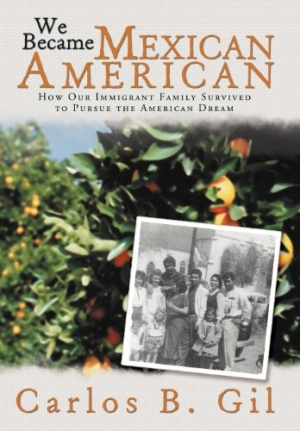We Became Mexican American
How Our Immigrant Family Survived to Pursue the American Dream
Memoirists routinely face the daunting task of sifting through family stories, trying to separate fact from fiction. Some authors decide the difference is insignificant and focus on one person’s subjective experience. Others objectively document family history with artifacts like marriage certificates and military records. In We Became Mexican American, Carlos B. Gil combines both methods to create a rich, textured portrait of his family from the time they immigrated from Jalisco, Mexico, to Northern California in the 1920s to the present.
Carlota, Gil’s grandmother, opens the story from Hacienda Santa Rosa, an agricultural estate where her family lived and worked as tenant farmers beholden to the landowners and the company store. With little chance of improving their situation in Jalisco, the Gils dreamed of escape. Stories of great opportunites in the United States convinced some to take the risk, including Carlota’s first son, Pascual, who led his family over the border and up the California coast in search of work, money, and security.
In order to tell the travelers’ tale, Gil uses details drawn from his extensive interviews with his aunts and uncles, the handwritten memoirs penned by his mother, and his own historical research. Gil’s scholarly expertise—he is an Emeritus Professor of History at the University of Washington—allows him to present a clear picture of the political and economic changes happening in the United States, starting with the Great Depression. Through his family’s experience as newcomers, he helps readers see the US through immigrants’ eyes. For instance, he describes their new world employing the Spanish words his grandparents used: vecindad for the Mexican housing projects and mezclilla for the ubiquitous blue jeans worn by workers.
Gil writes of an industrious father and selfless mother who did backbreaking work picking citrus and selling homemade tortillas around the clock to support their extended family, which included eight children. He does not portray them as perfect, however, allowing room for their mistakes. Gil remains a fairly neutral narrator even when discussing those closest to him, and while this detachment allows him to treat all family members equally, it can also create a disconcerting distance between himself and his subjects at times.
Even with four generations of an extensive family tree, Gil takes pains to explore the names and activities of each family member. His relatives will undoubtedly appreciate his thorough documentation, but the casual reader can easily lose track. That may be fine, though, for Gil’s message is about the overall arc of progress made by his family, not the individual experience of any one member.
We Became Mexican American shows how the hard work and determination of these Mexican immigrants led to greater economic success and higher social status with each generation. Black-and-white photographs inserted throughout the text vividly express this change of fortune. Early pictures show shirtless men aboard massive logging trains, while later photographs feature the fashionably dressed, smiling family with cameras around their necks, living the American Dream of prosperity at last.
Reviewed by
Sheila M. Trask
Disclosure: This article is not an endorsement, but a review. The publisher of this book provided free copies of the book and paid a small fee to have their book reviewed by a professional reviewer. Foreword Reviews and Clarion Reviews make no guarantee that the publisher will receive a positive review. Foreword Magazine, Inc. is disclosing this in accordance with the Federal Trade Commission’s 16 CFR, Part 255.

